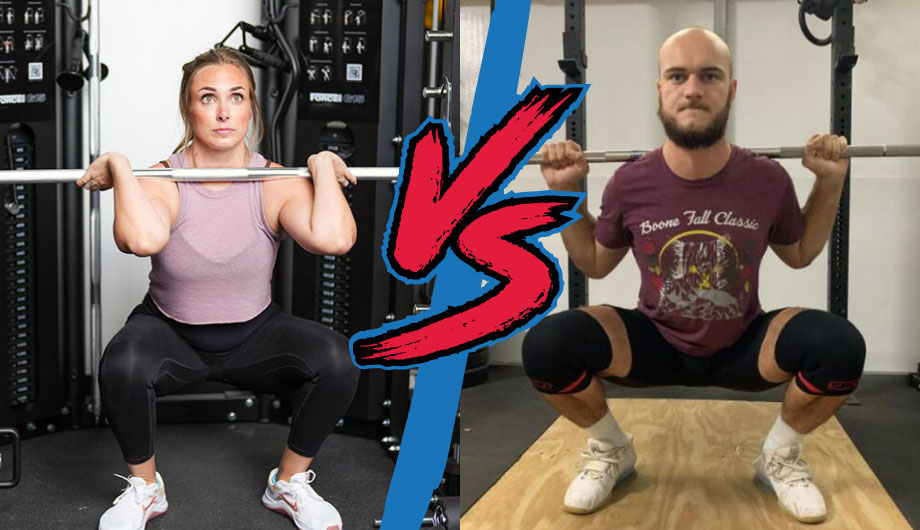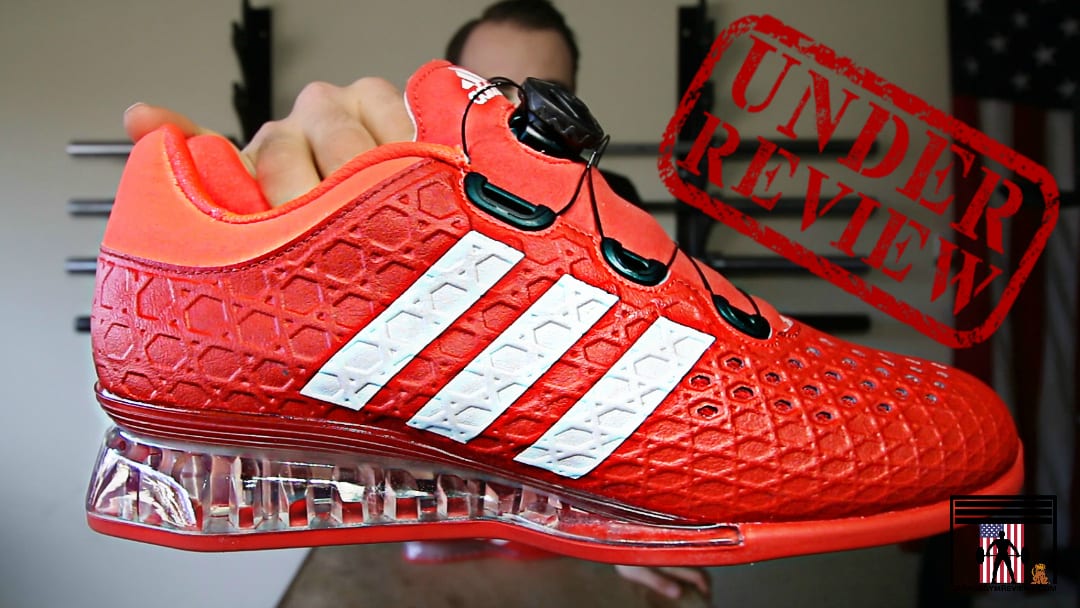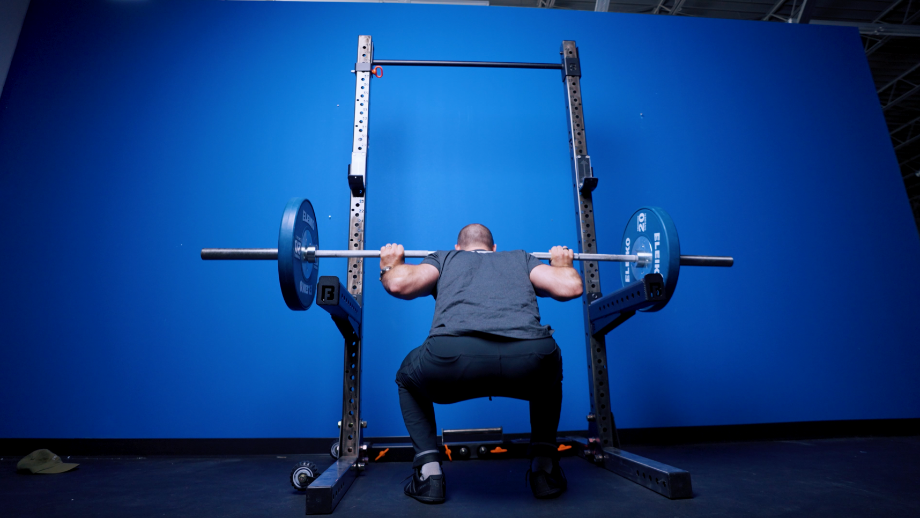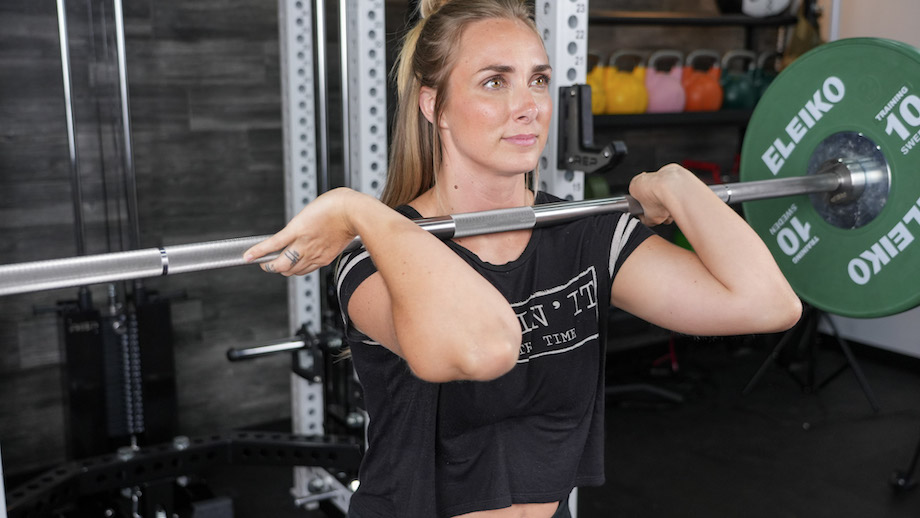Ask anyone for their top leg day exercises, and most people will probably mention one of my favorite foundational movements: the squat. A great way to target your quads, hamstrings, and glutes, this strength-training staple also effectively recruits your core muscles and upper-body stabilizers. However, like barbells, not all squats are created equal.
RELATED: 13 Benefits of Squats, According to an Olympian
As a certified personal trainer and longtime rugby player, the front squat vs back squat debate always makes me chuckle. Pitting the two variations against each other makes it seem like you have to choose just one. Yet, you can benefit from including both in your training program.
Whether your goal is to build strength, improve athletic performance, or grow your legs, understanding how and why to perform the front and back squat can help you inch closer to achieving your fitness goals.
Front Squat Vs Back Squat: Similarities
While the front squat and back squat are distinctly different, they share several fundamental similarities in their execution and muscle engagement.
- Both exercises effectively target the quadriceps, glutes, hamstrings, and core muscles.
- Front and back squats are primarily knee-dominant movement patterns.
- Front squats and back squats involve a similar motion where the lifter descends by bending at their hips and knees and then ascends to the starting position by pushing through the floor.
- Front and back squats are effective for building lower-body strength and muscle mass.
- Both versions require adequate joint mobility and stability, especially in your ankles, hips, and knees.
RELATED: What Muscles Do Squats Work?
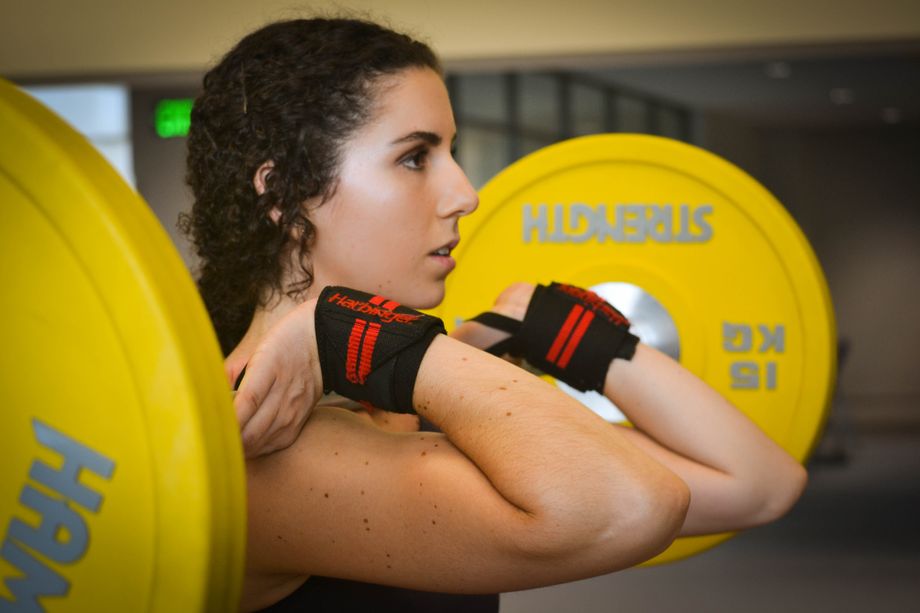
Front Squat Vs Back Squat: Differences
For all the similarities between the front squat and back squat, both exercises exhibit a few distinct differences:
- For the front squat, the barbell rests across your anterior delts (shoulders). On the other hand, back squats require you to create a “shelf” to rest the bar on by retracting your rear delts and engaging your traps.
- While front squats primarily target the quadriceps, back squats engage a wider range of lower body muscles, including the glutes and hamstrings.
- Front squats typically require a more upright torso position to keep the barbell balanced. Meanwhile, back squats involve a slight forward lean to stabilize the load on your upper back.
- Back squats generally allow you to lift heavier loads than front squats due to the placement of the barbell.
- Front squats necessitate greater upper-body strength and wrist mobility to maintain the rack position.
RELATED: Wrist Mobility Exercises
How To Do a Front Squat
Although it may look daunting, don’t be intimidated by the front squat. Executing clean reps requires properly positioning the barbell across the front of your shoulders, maintaining an upright torso, and engaging your core throughout the movement. Starting with a lighter load will allow you to grow comfortable with your front squat technique before you ramp up the intensity.
How to do it:
- Set up a barbell in a squat rack at chest height.
- Approach the barbell and position yourself under it with your feet shoulder-width apart.
- Grab the barbell slightly outside of shoulder-width using a palms-down grip.
- With your hands on the bar, swing your elbows forward until your triceps (the back of your arms) are parallel to the ground. This should create what’s called a front rack position, with the barbell resting across your collarbones. (Yes, it may feel uncomfortable at first.)
- Brace your core and lift the barbell off the rack, taking two steps back to clear the rack.
- Set your feet slightly wider than shoulder-width apart.
- Descend into a squat position by pushing your hips back, bending your knees, and keeping your chest up and back straight.
- Lower your body until the bottom of your thighs are parallel, or slightly below. Ensure your knees track over your toes throughout the squat.
- Drive through your heels to push yourself back up to the starting position, maintaining a strong core and upright posture.
- Repeat for the desired number of repetitions, then carefully place the barbell back onto the squat rack.
RELATED: How To Do Split Squats
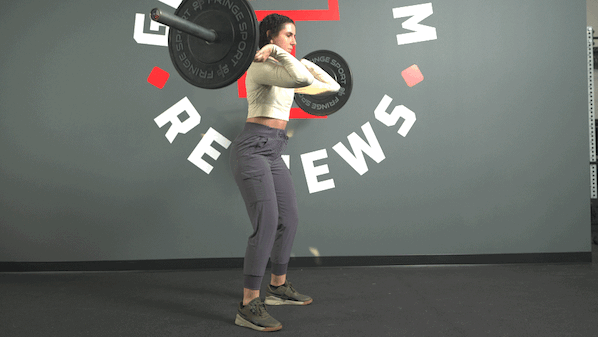
Benefits of the Front Squat
Whether you use a barbell, dumbbells, or kettlebells, front squats deliver a highly effective full-body stimulus. From recruiting your upper-body stabilizers to engaging your quads and core, this variation offers plenty of muscle- and strength-building upside.
RELATED: Best Dumbbells
Improves Core Stability & Reinforces Good Posture
Maintaining the proper bar position for front squats requires more than adequate elbow and wrist mobility. It also forces you to keep an upright torso from start to finish.
By recruiting and strengthening your abdominals, obliques, and other core muscles, front squats contribute to improved overall core stability and posture. A stronger, more stable core not only aids in lifting heavier weights but also helps reduce the risk of injury during other compound exercises and daily activities.
Enhances Quadriceps Development
Bodybuilders and physique-focused athletes often rely on squats to help them sculpt huge quads. While back squats also assist in this regard, a 2015 study1 shows that front squats activate your quads more. Combined with other exercises like leg extensions and lunges, you can create the signature tear-drop shape that’s synonymous with a well-developed vastus medialis.
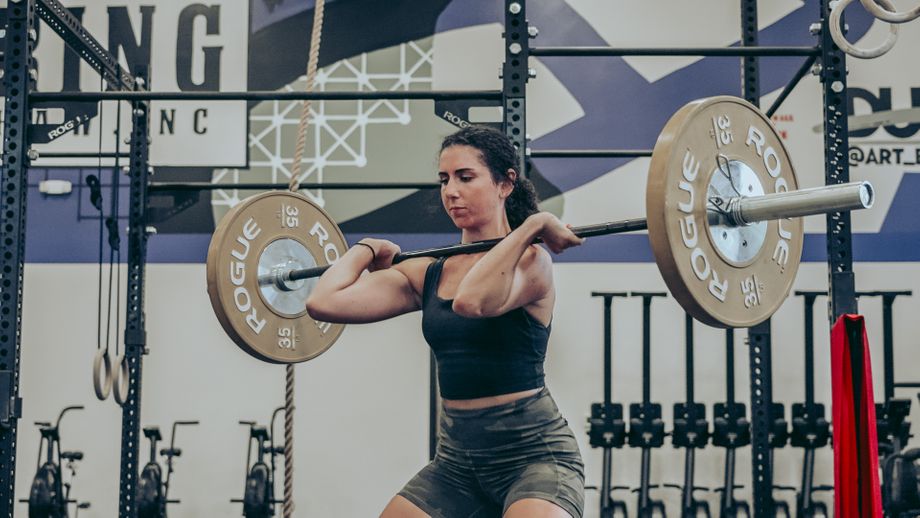
RELATED: Quad Exercises to Build Strength
Reduces Strain on Your Lower Back
Unlike back squats, front squats distribute the weight more toward the front of your body. This positioning results in less torque on your lower back, making front squats a viable option if you’re dealing with minor back issues or are working your way back from an injury.
Additionally, the reduced lower back strain in front squats may facilitate a smoother, more comfortable lifting experience, especially for those with pre-existing back pain.
Drawbacks of the Front Squat
While highly effective, front squats also present several potential drawbacks that you should consider before penciling them into your weightlifting program.
Limited Loading Potential
Front squats typically allow for lighter loads compared to back squats due to the positioning of the barbell across the front of the shoulders. For example, the heaviest back squats of all time are in excess of 1,000 pounds, while the heaviest front squats very rarely exceed 700 pounds. This limitation in loading potential may hinder maximal strength development, especially for advanced lifters aiming to lift heavy weights and achieve significant muscle hypertrophy.
RELATED: Hypertrophy Workout 101
Requires More Technical Precision
Front squats require more technical proficiency and mobility, particularly in your wrists, shoulders, and thoracic spine. The rack position, where the barbell rests across your front delts and collarbones, demands greater wrist flexibility and shoulder mobility to maintain stability and prevent discomfort during the lift.
Furthermore, maintaining an upright torso throughout the movement further emphasizes thoracic mobility and core strength. Beginners or individuals with limited mobility may find this type of squat pattern challenging to perform correctly, leading to poor form and potential injury.
RELATED: Heel-Elevated Goblet Squat: Expert Tips
Places Stress on Your Wrists
The front rack position places considerable pressure on the wrists as they support the weight of the barbell. This can lead to discomfort or pain, especially if you have pre-existing wrist issues or limited wrist flexibility.
While using the best wrist wraps or certain grip variations—such as the clean or cross-arm grip—can provide some relief, they may still pose challenges for some lifters. If that’s the case, you may want to stick to back squats and other squat variations until you feel comfortable.
How To Do a Back Squat
Other than the bar position, the same basic principles apply when performing the back squat vs. the front squat. You’ll need to create a shelf for the bar to rest on, set up in a proper stance, and keep your core engaged throughout this push-focused lower-body movement.
Where you create that “shelf” depends on whether you’re performing a high-bar or low-bar squat. The former involves resting the barbell across the top of your shoulders and using a wide grip to maintain control. The latter places the barbell lower on your back (across your posterior delts), resulting in a more pronounced forward lean and increased posterior chain muscle activation2.
Since most people tend to perform high-bar squats, these instructions will help you master the proper technique.
RELATED: Learn More About How To Master the Back Squat
How to do it:
- Set up a barbell on a squat rack at upper-chest height.
- Grab the barbell with an overhand grip slightly wider than shoulder-width.
- Dip beneath the bar, place the bar across your upper back, and create a “shelf” for it to rest on by retracting your shoulder blades and pulling your elbows into your body.
- Brace your core and lift the barbell off the rack, taking two steps back.
- Set up with your feet just wider than shoulder-width with your toes pointed out slightly.
- Descend into a squat position by pushing your hips back and bending your knees, keeping your chest up and back straight.
- Lower your body until the bottom of your thighs are parallel to the ground or slightly below, ensuring your knees track over your toes.
- Drive through your heels to push yourself back up to the starting position, maintaining a strong core and upright posture.
- Repeat for the desired number of repetitions, then carefully rack the barbell back onto the squat rack.
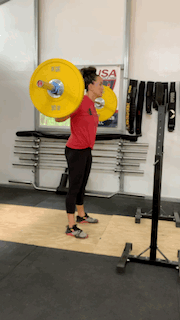
Benefits of the Back Squat
A cornerstone exercise in the powerlifting community, the back squat is widely known for delivering comprehensive lower-body strength development. Targeting multiple muscle groups—including the quadriceps, glutes, hamstrings, and spinal erectors—it’s an effective compound movement that challenges you physically and mentally from the moment you set up to re-racking the barbell.
Increases Overall Strength and Muscle Mass
Back squats are one of the best exercises for building leg strength. You can typically load more weight than with front squats, allowing you to take advantage of progressive overload principles. Plus, just like with front squats, you can vary your stance and tempo to get even more hypertrophy rewards out of your training.
Activates Your Posterior Chain
Back squats target the same lower-body muscles as front squats but place more emphasis on your posterior chain, particularly your glutes, hamstrings, and lower back muscles. The bar position on the upper back necessitates hip extension during the ascent phase of the squat, engaging your glutes and hamstrings to a greater extent.
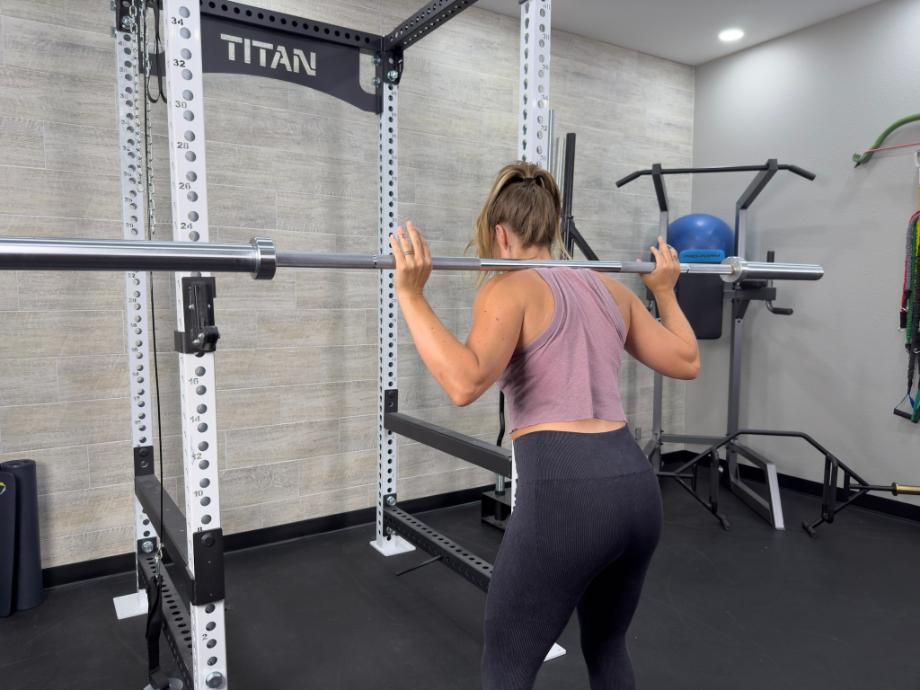
This posterior chain activation contributes to balanced lower-body development and enhances your athletic performance and power production3.
RELATED: 13 Posterior Chain Exercises From a Personal Trainer
Enhances Stability and Balance
Back squats require coordination and stability throughout the entire kinetic chain to maintain proper form and balance under load. Balancing the barbell on your upper back engages the core muscles, including the abdominals and obliques, to stabilize your spine and prevent excessive forward or backward leaning.
Additionally, the stability demands of back squats extend to your ankles, knees, and hips, as these joints must work synergistically to control the eccentric (lowering) and concentric (lifting) phases of the squatting motion. The improved stability and balance back squats grant you will tangentially improve your athletic performance (think jumping, sprinting, and throwing).
Drawbacks of the Back Squat
As much as my clients and I love back squats, there are a few potential downsides to remember.
Increases Stress on Your Lower Back
Because the barbell is positioned on your back, this squat variation places a significant load on your spine, particularly the lumbar region. While proper form and technique can mitigate this stress, improper execution or excessive loading4 may increase the risk of lower back strain or injury.
If you have a pre-existing back issue or poor lumbar spine mobility, you may want to stick with bodyweight squats and other variations that don’t cause discomfort until you’re ready for the barbell. Goblet squats, sandbag squats, Zercher squats, and Bulgarian split squats are alternative movements you can substitute for back squats.
RELATED: 17 Lower Back Exercises to Try for Stability And Strength
Risk of Forward Lean and Knee Stress
Back squats require you to lean forward slightly to maintain balance and stability, especially when you’re working with heavy loads. This forward-leaning torso position, combined with knee flexion during the descent phase, can cause discomfort in your knee joints.
Based on the results of a biomechanical comparison5 of both squat variations, front squats may be a superior choice if you have knee problems.
Front Squat Vs Back Squat: Which Should You Do?
Whether you should choose between front squats or back squats depends on your training style, fitness goals, and individual preferences. However, you can incorporate either variation into your programming. Both movements will provide results if you utilize proper form and work with an appropriate load.
Beginners or those with mobility restrictions may benefit from starting with front squats to build foundational strength and address mobility issues. In addition, Olympic weightlifters and CrossFitters can rely on this exercise to develop power and coordination that carries over to their respective sport.
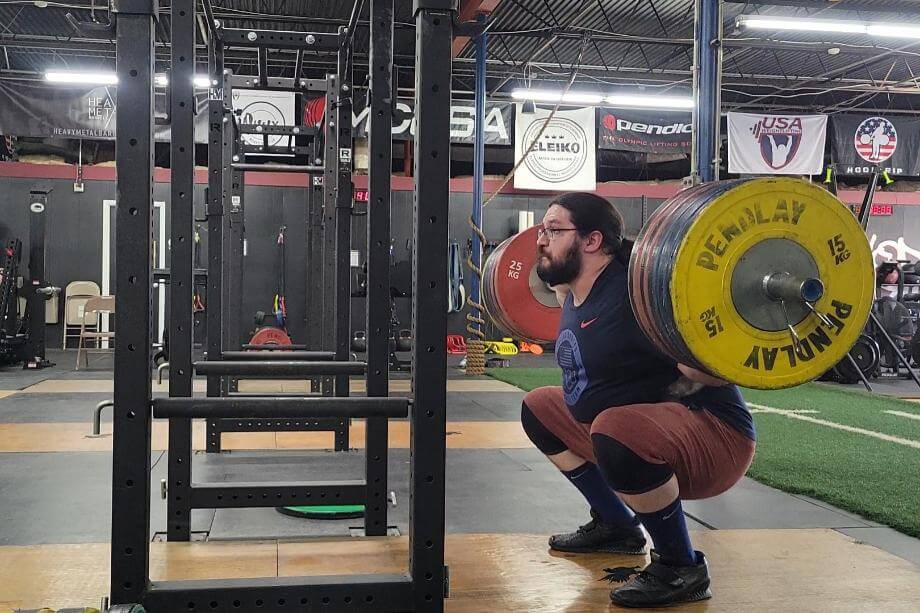
On the other hand, powerlifters or those focused on achieving maximum strength and muscle gains may prefer back squats. Whether you go with a high-bar or low-bar approach, you will likely be able to lift more than you would with a front squat.
RELATED: Powerlifting Training
Front Squat Vs Back Squat: Final Thoughts
There’s no reason you have to ditch one squat variation for the other. Front and back squats each offer muscle- and strength-building benefits that can help you become a more confident, well-rounded athlete. Incorporating both versions into your workout routine will ultimately allow you to reap the best results, as you can effectively target your glutes, quads, hamstrings, and core, build strong, stable shoulder joints, and develop the technical prowess to master one of the most popular and effective movement patterns.
Front Squat Vs Back Squat: FAQs
Should you do front squats or back squats?
Whether you choose front squats or back squats depends on your individual goals. Front squats emphasize quad strength and place less stress on the lower back, while back squats allow for heavier loads and engage your glutes and hamstrings more. Incorporating both variations can offer a balanced approach to lower-body strength training.
Which squat variation is better for targeting the quadriceps?
Front squats are generally better for targeting the quadriceps due to the more upright torso position as a result of the bar placement. This exercise also requires more knee flexion, further engaging your quadriceps muscles.
RELATED: Squat Anatomy
Can you go heavy on front squats?
Yes, you can go heavy on front squats, but the weight you lift may be slightly less compared to back squats due to the biomechanical differences.
References
- Yavuz HU, Erdağ D, Amca AM, Aritan S. Kinematic and EMG activities during front and back squat variations in maximum loads. J Sports Sci. 2015;33(10):1058-66. doi: 10.1080/02640414.2014.984240. Epub 2015 Jan 29. PMID: 25630691.
- Murawa, M., Fryzowicz, A., Kabacinski, J., Jurga, J., Gorwa, J., Galli, M., & Zago, M. (2020). Muscle activation varies between high-bar and low-bar back squat. PeerJ, 8. https://doi.org/10.7717/peerj.9256
- Leong CH, Forsythe C, Bohling Z. Posterior chain and core training improves pelvic posture, hamstrings-to-quadriceps ratio, and vertical jump performance. J Sports Med Phys Fitness. 2024 Jan;64(1):7-15. doi: 10.23736/S0022-4707.23.15171-1. Epub 2023 Oct 6. PMID: 37800401.
- Sohn J, Koo D. Effects of load increase on lower extremity kinetic and kinematic variables in the back squat exercise. Technol Health Care. 2023;31(S1):247-258. doi: 10.3233/THC-236021. PMID: 37066926; PMCID: PMC10200205.
- Gullett JC, Tillman MD, Gutierrez GM, Chow JW. A biomechanical comparison of back and front squats in healthy trained individuals. J Strength Cond Res. 2009 Jan;23(1):284-92. doi: 10.1519/JSC.0b013e31818546bb. PMID: 19002072.


